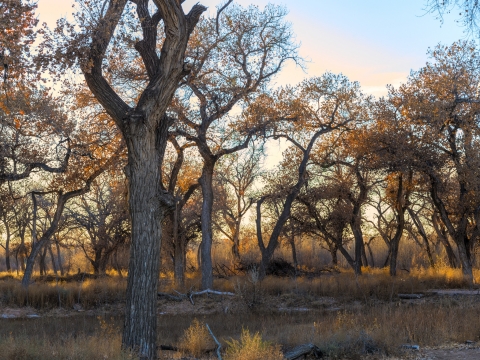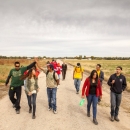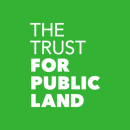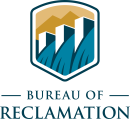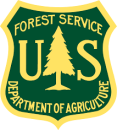Location
States
New MexicoEcosystem
River/stream, WetlandIntroduction
As an Urban Wildlife Refuge, Valle de Oro NWR serves as an urban oasis for both wildlife and people. Wildlife observation and photography, youth employment, and environmental education and interpretation are main attractions of Valle de Oro NWR. As a green space close to the Mountain View neighborhood, the Refuge also increases recreational opportunities for biking, horseback riding, walking, and relaxing. The Refuge collaborates and interacts with the surrounding community in diverse ways—from art performances to environmental justice summits. Over 10,000 individuals a year participate in special events, environmental education, outreach, and interpretation programs on and off Refuge lands. The integration of nature-based solutions into day-to-day work, such as creating and maintaining green spaces in urban areas, provides for human well-being and biodiversity benefits. The Service has identified nature-based solutions as a key strategy in the Climate Change Action Program to unify its climate response in accordance with the Department of the Interior’s Nature Based Solutions Policy.
Key Issues Addressed
The future success of conservation lies ultimately in the ability to inspire people to connect with the outdoors and nature. With more than 80% of Americans now living in urban areas, this is a challenge. Refuges close to highly-populated areas, such as Valle de Oro NWR, provide the greatest opportunity to engage new and diverse audiences by increasing access to natural areas.
Additionally, environmental injustices have long persisted in the community surrounding the Refuge, Mountain View Neighborhood, a heavily industrial community, populated by a majority of people of color. Valle de Oro NWR was created through strong collaborative partnerships and community input in response to these issues.
Project Goals
Valle de Oro NWR is being built using the Urban Refuge Standards of Excellence, such as:
- Connect urban people with nature via Stepping Stones of Engagement
- Know and relate to the community, build partnerships, and become a community asset
- Ensure adequate long-term resources and provide equitable access, ensuring that visitors feel safe and welcome
- Model sustainability
Project Highlights
A Community’s First Green Space: The Mountain View neighborhood surrounding the Refuge has battled against many environmental injustices and previously lacked green space and healthy outdoor recreation opportunities.
- Collaboration for Land Acquisition: Through a consortium of federal, state, and local partners, the Refuge worked with The Trust for Public Land to purchase the land from Price’s Dairy Farm from 2012 to 2014. In the next few years, the land will be restored to native Rio Grande floodplain ecosystems, but currently, an agreement with a local farmer will allow farming until restoration begins.
- Community Engagement: From the beginning, the Refuge has used community input to determine how to develop the Refuge and determine which features would make it a place they would visit frequently and be proud to support. The Refuge continues to involve the community in each stage of its development and restoration and aims to appeal to non-traditional, urban visitors.
- Economic and Environmental Justice Strategic Plan (EEJSP): The Plan outlines a strategic path forward for the Refuge to integrate environmental and economic justice into its daily practice as the land is restored for wildlife and developed as an educational and recreational resource for the community.
- Youth Engagement and Employment:The Refuge is committed to providing quality, in-depth environmental education, citizen science, service learning, and employment opportunities for youth and young adults. The Refuge works with many partners for these efforts. These include the Bosque Ecosystem Monitoring Program and Rio Grande Phenology Trail, which provide opportunities for schools across Albuquerque to do hands-on monitoring in the Bosque, as well as EarthForce, which engages youth in citizen science and civic action related to water in their community. The Middle Rio Grande Urban Conservation Corps program provides diverse work experience on public lands, including life skill training, natural resource education, and conservation career mentoring. Additionally, the Refuge hosts and supports the Merge Alliance, an organization that encourages collaboration between organizations who work in environmental education, youth employment, and outdoor recreation in the Albuquerque area. Young adults are involved in a variety of projects on and off Refuge land with a variety of community partners including the Southwest Conservation Corps, La Plazita Institute, Rocky Mountain Youth Corps, and New Mexico Youth Conservation Corps. Projects have included collecting oral histories of the Refuge’s lands, building a Nature Explore Classroom at a local community center, building fence and repairing trails at recreational sites, characterizing forest health, and many others. For many of these young adults, employment in a youth corps, being part of a team, and giving back to their community and the land have been life changing experiences.
- Habitat Restoration: More than 80% of wetlands in the Middle Rio Grande Valley have been lost due to urbanization, farming, and Rio Grande flow regulation. In the next few years, approximately 530 acres of Refuge lands will be restored to native bosque ( riparian riparian
Definition of riparian habitat or riparian areas.
Learn more about riparian woodlands) and upland habitat. These efforts will not only benefit and support a greater diversity of wildlife but will also create a community green space and environmental education center while protecting and restoring the health and vitality of the adjacent Rio Grande bosque, demonstrating the multiple benefits associated with nature-based solutions.
Lessons Learned
- Using most aspects of Refuge development as opportunities for youth and community engagement and education has contributed to the success of the Refuge. Expanding the Refuge’s presence beyond its physical boundaries to projects such as planting community gardens, giving presentations in schools, and hosting high school interns, has strengthened ties to the community.
- Strong and diverse partnerships are key to the continued success and growth of the Refuge. Successful partnerships are dependent on shared ownership, frequent communication, and the cultivation of multiple actively engaged individuals within each partner organization. Leveraging money with partnerships helps increase financial buy-in.
- Leveraging local opportunities has allowed the Refuge to progress outside of the standard Refuge model. It is important to be open to “new” ideas that come from the community.
- All partners want to have their wants and needs addressed, which can be a challenge. The Refuge, in turn, has to weigh all interests and create a balance between these wants and needs. While ideas such as paintball courses and soccer fields may not be compatible with Refuge goals, a native plant nursery could benefit all partners.
- Keeping up with the rapid expansion of the Refuge, and all its projects and plans, has been a challenge. Refuge staff are working to balance their commitments to ensure success of partnerships and projects alike. Momentum and engagement are maintained by saying “not yet” instead of “no.”
Next Steps
- Continue to engage the community through shared leadership, partnerships, and youth engagement.
- Continue to host annual partner summits, which are opportunities for all partners to celebrate accomplishments, build relationships, and discuss plans for the future.
- Identify and secure additional funding and partnerships.
- With the help of volunteers, community members, and youth crews, restore 510 acres of agricultural fields and 56 acres of dairy farm infrastructure into native Rio Grande floodplain ecosystems per plans outlined in the Environmental Assessment.
- Develop a visitor center complex along with outdoor classrooms, maintenance facilities, and up to 10 miles of walking and multi-use trails.
- Focus on Refuge outreach and marketing, including promoting the Friends of Valle de Oro capital campaign for Refuge marketing.
Funding Partners
- Bernalillo County
- Albuquerque Metropolitan Arroyo Flood Control Authority
- National Fish and Wildlife Foundation
- Walmart
- Bureau of Reclamation
- Land and Water Conservation Fund
- Wells Fargo
- The State of New Mexico
- North American Wetlands Conservation Act
- The Trust for Public Land
Resources
- Associated Case Study on the Bosque Ecosystem Monitoring Program
- Valle de Oro National Wildlife Refuge Website
- Valle de Oro Facebook Page
- Map of Selected Alternative of the Environmental Assessment and Next Steps
- Environmental Assessment
- Economic and Environmental Justice Plan
- Valle de Oro Overview Video
- Video on the History and Vision for Valle de Oro
- Mountain View Community Center
- Mountain View Elementary School
- Mountain View Neighborhood Association
- Rio Grande Phenology Network
Contacts
- Valle de Oro NWR: valledeoro@fws.gov
- Jennifer Owen-White, Refuge Manager: jennifer_owenwhite@fws.gov
Case Study Lead Author
Rae Robinson, formerly Americorps Vista, Cross-Watershed Network
Suggested Citation
Robinson, R. (2019). “Valle de Oro National Wildlife Refuge: An Urban Wildlife Refuge.” CART. Retrieved from https://www.fws.gov/project/valle-de-oro-urban-wildlife-refuge.

